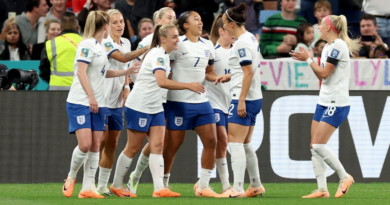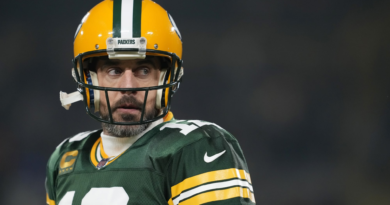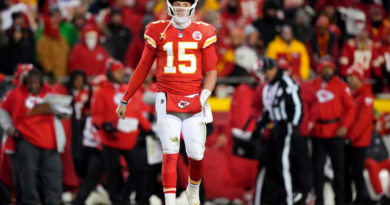What made Rapinoe so good? Teammates, opponents and coaches break it down
On Sunday, Megan Rapinoe will don a U.S. women’s national team jersey for the final time. She’ll have recorded over 200 caps, and she’ll step on the Soldier Field turf with 63 international goals to her name, and the hope that she’ll add to that tally.
For those in attendance — and even those watching on television — it’s an event that figures to evoke both joy and some sadness, too. Saying goodbye is never easy, even if it’s just one part of Rapinoe’s life that is coming to an end.
But veteran defender and co-captain Becky Sauerbrunn wouldn’t miss this for anything. The Portland Thorns defender and longtime international teammate of Rapinoe’s will be among those in the crowd, and she expects to feel the full range of emotions.
– Stream on ESPN+: LaLiga, Bundesliga & more (U.S.)
– Read on ESPN+: Projecting USMNT club seasons in Europe
“I think we kind of always thought our careers were probably going to end at the exact same time, like a little pact that when she hung up the boots, I was probably going to hang up the boots, but it just didn’t work out that way,” Sauerbrunn said. “So I’m just sad.
“It feels like a closing of a major chapter, somebody that I’ve known for so long, grew up with both as a human, but also babies of the system too. So, yeah, it’s sad, but I’m also like, ‘What a career she’s had and all the things that she’s done off the field.’ I mean, what a way to do it.”
Sauerbrunn first met Rapinoe when they were called into a camp for the U.S. U-16 national team, and Sauerbrunn was immediately drawn to her charisma. It started a friendship that has continued for over 20 years.
“I was just like, ‘Dang, this chick’s really cool,'” Sauerbrunn said with a laugh. “She just had this, like, swag about her even at that age. We’re all kind of a little uncomfortable with ourselves, and she just didn’t really have that. She kind of just was like, ‘This is me, my humor, my personality — take it or leave it.’ She just had gravity and she’s had that throughout as long as I’ve known her that people are just drawn to her. I was like, ‘Man, she’s really cool. I’m gonna try to be her friend.'”
Sauerbrunn isn’t the only one exploring the depths of the Wayback Machine, as tributes are pouring in from teammates and opponents alike. The memories run the gamut too, from what she accomplished on the field to her advocacy off it.
But it all starts with Rapinoe the player, and in terms of pure ability, she will be remembered as one of the most gifted of her generation. Sure, Rapinoe’s ending with the U.S. women’s national team at the last World Cup fell well short of what she and the team wanted. But the totality of her career — one that contained back-to-back World Cup titles and an Olympic gold medal — minimizes that disappointment.
In her youth, Rapinoe was a more central player, but by the time she got to the USWNT she was a wide midfielder, where she excelled. This included the monumental delivery to Abby Wambach for the equalizer against Brazil in the quarterfinals of the 2011 Women’s World Cup.
“I think it was a combination of technical proficiency and IQ,” said Rapinoe’s former coach Jill Ellis, a two-time World Cup-winning manager with the USWNT, and now the GM for NWSL side San Diego Wave. “Megan has very, very good instincts. She has the understanding of when to come inside, when to stay wide, and then she became the most, I think, extraordinary crosser of the ball.”
10 #FIFAWWC goals.
Today we introduce @AbbyWambach for @USWNT 🇺🇸 against @CBF_Futebol 🇧🇷 in 2011.
Is this the #GreatestGoal? pic.twitter.com/1grR2t9zAi— FIFA Women’s World Cup (@FIFAWWC) May 5, 2019
John Herdman found himself on the business end of that ability more times than he cared to count. Herdman is poised to take over MLS side Toronto FC, but he previously managed the women’s teams of Canada, the USWNT’s arch-rivals, and New Zealand before that. He was in the technical box during the epic 2012 Olympics semifinal between the U.S. and Canada, when Rapinoe’s two goals — including one directly from a corner — helped the U.S. prevail 4-3.
Such was Rapinoe’s crossing ability that Herdman compares Rapinoe to former England star David Beckham.
“I would just remember Rapinoe’s crosses were, when she was in her prime, just undefendable,” he said. “Like if she was going to cross the ball and Wambach was in the box, you were in trouble.”
It wasn’t just the pace with which Rapinoe hit crosses, although she did whip them in with power. Her vision and timing were what made her crosses so lethal.
“Her ability to see danger and space and to be able to serve it — it’s one thing to be able to identify it and another to be actually able to execute the technique of it,” Sauerbrunn said. “But her ability to just whip balls in behind me as a back line, in front of me …
“There’s not many people that I’ve played with can strike a ball like she can, whether it’s like the spin on it, the dip on it, it’s rare and it’s made her, I think, just so dangerous through the years.”
Herdman, as an opposing coach, did what he could to limit that ability. He admitted he would try to engage in some sideline banter with Rapinoe.
“It wouldn’t work,” he said.
The former Canada manager had some practical approaches to stopping Rapinoe as well. But it also created a cascade effect. Going to extra lengths to shut down Rapinoe meant conceding space to another U.S. player.
“I always said with Megan, you had to stop the cross,” Herdman said. “It was always about trying to get double cover because when you isolate one-v-one with Rapinoe, she has got that ability to beat you one-v-one as well. She had that knack of being able to create that yard for the cross, so you had to get two people out there to give the person on the ball the confidence to get that tight to it, to really suffocate the space she needed.”
But there are always moments in a game when a defender would be out on an island against Rapinoe. For NJ/NY Gotham FC and former U.S. international defender Ali Krieger, that meant finding a middle ground in terms of how best to defend her long-time friend.
“I try not to get too close so I don’t get beat and then I may look silly,” said Krieger. “But you can’t let her out of your sight and you can’t be too far. She doesn’t like to defend too much, so I know she kind of hangs out a little bit here and there. As soon as I see a player wanting to pick her out, and play her a ball, you just have to close it down quickly, and be there to try to affect it as best as you can.”
3:17
Unapologetically Rapinoe: A story of Megan Rapinoe’s legendary career
Sue Bird guides us through Megan Rapinoe’s legendary journey as a USWNT superstar and the transcending work she’s done around the world.
Then there were the more brute force methods of containment. When former teammate Jasmyne Spencer, now with Angel City FC, was asked how to stop Rapinoe, she simply said, “Foul her.”
And did she?
“Many times,” she said with a chuckle. “And then we’d laugh about it after.”
Part of Rapinoe’s success was down to her ability to exploit space and try the unexpected. “Predictably unpredictable,” is how former USWNT teammate and goalkeeper AD Franch, now with the Kansas City Current, put it. Franch recalled one time how Rapinoe hit a drive with her back to goal — Franch made the save, only to be beaten later on a free kick.
Such athletic attributes will only get a player so far, though. The psychological aspects of the game are always what separate good players from great ones — and Rapinoe delivered more times than not.
Whether it was in the aforementioned Olympic semifinal, or the 2019 Women’s World Cup, when she scored six goals and three assists — all while the president of the United States publicly went after her — which garnered her the Gold Boot as the tournament’s leading scorer, as well as the Golden Ball as the tournament’s top player, Rapinoe always seemed to hold the mental edge when she needed it.
“I’ve always said this about ‘Pinoe: The bigger the moment, and the bigger the demand, the more she welcomes that spotlight, and the bigger she can play,” said Ellis. “And as a coach, you need your top players to step up in top moments.”
Rapinoe’s ability to keep the mood light even in the most high-stakes tournaments was also a vital asset for the team. Her USWNT teammates have talked about her ability to take on the media so the rest of the team didn’t need to, and they’ve praised Rapinoe’s ability to make the locker room fun.
“She just knows what to say to break the tension or to get the energy going,” Sauerbrunn said. “She has a real gift with her humor — and sometimes it’s so dry and sometimes it’s so inappropriate, but it’s just like you have to chuckle and smile around her.”
Rapinoe’s advocacy for the Black and LGBTQIA+ communities, as well as being at the forefront for the USWNT’s quest for equal pay, also sparked memories from those who worked with her over the years. Athlete Ally, an LGBTQIA+ advocacy group, lauded Rapinoe’s contribution with a statement on the group’s website.
“Megan has never wavered in using her platform to champion the kind of future we want for all LGBTQI+ youth — one where they are free to be exactly who they are, and play the sport they love,” the statement read in part.
Rapinoe took a knee in September 2016 during the national anthem prior to a USWNT game as a way of supporting former NFL quarterback Colin Kaepernick, who was protesting racial inequality. Rapinoe caught the ire of those who disagreed with her choice to kneel, and not long afterward U.S. Soccer effectively threatened her position on the USWNT if her protest continued by making it a bylaw that national team players must stand during the anthem.
Spencer, who is on the board of the Black Women’s Players Collective, an advocacy group for the NWSL’s black players, said Rapinoe’s willingness to speak out, even when she didn’t need to, made her a special player off the field — and the 2016 protest stood out.
“This is what we need: people who are allies of the Black community and willing to use their platform to shine light on some of the injustices that we all face on a daily basis,” Spencer said. “I hadn’t played with her at that point and had always admired her as a player, and that just really made me admire her as a person too.”
Sauerbrunn was at that game in 2016, and walked away even more impressed with how Rapinoe handled the full range of responses.
“I saw that people would come up to her and thank her for that,” Sauerbrunn said. “And then I was also there to see the people that just spewed hate about it. And to see the grace that she walked with all of that, and her bravery and knowing that she was doing the right thing. It was really, for me, it made me more brave because of her.”
Former teammates and even opponents remembered kind gestures from Rapinoe, far away from the spotlight.
Herdman recalled how he attended a Seattle Reign match shortly after the start of the NWSL. Rapinoe spotted Herdman on the sideline with his kids and after the final whistle offered up her jersey to his then-three-year-old daughter Lilly. Lilly wasn’t interested but big brother Jay was more than happy to take it.
“A week later Jay is running around with a women’s cut Seattle and Megan Rapinoe jersey on in the back garden, with his football,” he said. “It just made us laugh.”
Rapinoe was free with advice, too. Franch recalled how during her first training camp with the USWNT back in 2012, Rapinoe sat down next to her during a team meal.
“She basically called me out and was like, ‘That’s not going to be enough, kid.’ I didn’t have enough on my plate to be able to get through the training,” Franch said, laughing. “I will say she was accurate.”
Ellis remembered how during the 2019 World Cup, Rapinoe spoke to teammates who were going through the first World Cup and encouraged them to talk out any anxiety they were feeling.
“A player didn’t have to hide that they were stressed or nervous,” Ellis said. “I think that just made it very, very real. Those were moments that I just remember her helping the team.”
The reality of being on a professional soccer team is that the time isn’t just about training and games and meetings. There are meals and quieter times spent hanging out with teammates. Those moments create some of the most enduring memories.
“I know that our memories going out to dinners and things outside of soccer, were actually so much more memorable, other than winning championships,” said Krieger. “Really spending quality time and building friendships in that pressure environment is really what matters most because you need your friends. You need your people that you can lean on through those tough times and through the best times — and I consider her to be that for me.”




